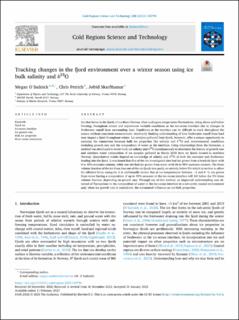| dc.description.abstract | Ice that forms in the fjords of northern Norway often undergoes temperature fluctuations, rising above and below freezing, throughout winter and experiences variable conditions at the ice-ocean interface due to changes in freshwater runoff from surrounding land. Conditions at the interface can be difficult to track throughout the season without consistent measurement, resultantly limiting understanding of how freshwater runoff from land may impact a fjord throughout winter. Ice samples gathered from fjords, however, offer a unique opportunity to examine the connection between bulk ice properties like salinity and δ18O and environmental conditions including growth rate and the composition of water at the interface. Using relationships from the literature, a method was developed to invert bulk ice salinity and δ18O simultaneously to determine the history of growth rate and interface water composition of ice samples gathered in March 2018 from six fjords located in northern Norway. Quantitative results depend on knowledge of salinity and δ18O of both the seawater and freshwater leading into the fjord. It was found that five of the six investigated sites had ice grown from a brackish layer with 0 to 40% seawater content, while one site had ice grown from water with 50 to 90% seawater content. The brine volume fraction of the ice from four out of the six fjords was partly or entirely below 5% which is too low to allow for efficient brine transport. It is additionally shown that at ice temperatures between −2 and 0 °C, ice grown from water having a composition of up to 30% seawater at the ice ocean interface will fall below the 5% brine volume fraction, depending on growth rate. Through use of this method, an improved understanding was obtained of fluctuations in the composition of water at the ice-ocean interface in a sub-arctic coastal environment and, when ice growth rate is considered, the substantial influence on ice bulk properties. | en_US |
